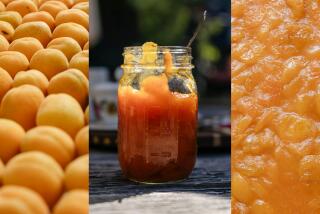Stop! In the Name of Jam
- Share via
Don Harper remembers the day last spring when L.L. Bean told him that there was a complaint about his jam. “I was stunned,” says Harper, whose Whistling Wings Farm had been making the product for eight years under the Bean private label. Someone had accused the mail order giant of not selling real jam. “I immediately sent a jar to an independent lab to be tested for conformance to FDA requirements.”
The jam failed the test.
Harper called the FDA to find out why. To his astonishment, the agency told him that to be labeled jam or preserves, a product must contain not less than 65% sugar. Whistling Wings blueberry jam contained only 47% sugar, the raspberry slightly more. The FDA gave Harper two options: He could change the jam or change the label. If Harper added additional sugar, he could continue to call it “jam.” If he left it as it was, he had to change the label to read low-sugar or dietetic “spread.”
Suddenly, Harper was in the same boat as Wolfgang Puck, who had trouble a few years ago when he tried to market frozen pizzas: The Department of Agriculture said his products didn’t qualify as “pizza” because they contained no tomatoes. Rather than settle for the label “cheese pie,” Puck got around the ruling by adding a couple of slices of tomatoes to each pizza.
For Harper, there were no such easy solutions. He’d always been extremely proud of his jam, and of the fact that it contained a lot of fruit, a little sugar, some pectin, and nothing else. This, he says, is what made his jam taste better than other products--you tasted the fruit instead of the sugar. The fact that it was good for you was a bonus.
“It was mislabeled, sure,” he says. “But its healthfulness was something we have been trying to promote for years. Thinking about it, we felt relabeling would actually help sell the product.”
But relabeling the product did not sit well with the people at L.L. Bean. They gave Harper an ultimatum: Add more sugar or lose Bean’s business, which Harper says was worth $80,000 a year at the time to his small Biddeford, Maine-based company.
He’d been through a similar dilemma before.
“At one time,” Harper says, “we made the raspberry and blueberry syrup for L.L. Bean--they contained just fruit, sugar and pectin. A couple of years ago Bean decided to go with a syrup made with flavored corn syrup instead. It contains so little fruit the producers have to use dye to get it the right color. Now Bean wanted me to do the same thing they did with the syrup: start putting out a product that anyone can buy in any grocery store. People automatically assume it is the best quality because that is the image L.L. Bean has spent years trying to perfect.”
Harper refused to change his jam. Soon after, he got a letter from Robert Fry, senior vice president of merchandising for L.L. Bean. “It is my understanding,” wrote Fry, “that you were reluctant to change your product to these (FDA) standards (for jam).” The letter went on to say that L.L. Bean would be buying its private-label jams from somebody else.
“It’s a lot cheaper to make a product with more sugar than fruit,” says Harper simply.
“Price was not the issue,” says Deborah Barney, director of product development for L.L. Bean, “essentially the new vendor was better able to meet our needs.”
Today L.L. Bean’s jams and syrup are made by Schlotterbeck & Foss, another Maine-based company. “The product we are offering now,” says Barney, “actually has more fruit in both the syrup and the jam than our former product.”
Replies Harper: “Just read the labels.”
More to Read
Eat your way across L.A.
Get our weekly Tasting Notes newsletter for reviews, news and more.
You may occasionally receive promotional content from the Los Angeles Times.








